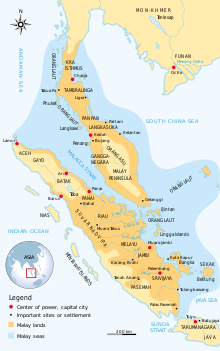Pannai Kingdom | |
|---|---|
| 11th century–14th century | |
| Capital | Pannai |
| Religion | Vajrayana Buddhism |
| Government | Monarchy |
| History | |
• Established | 11th century |
• Disestablished | 14th century |
| Today part of | Indonesia |
| History of Indonesia |
|---|
 |
| Timeline |
|
|
Pannai, Panai or Pane was a Buddhist kingdom located on the east coast of Northern Sumatra that existed between the 11th and 14th centuries.[1] The kingdom was located on the Barumun River and Panai River valleys, in today's Labuhan Batu and South Tapanuli regencies. Because surviving inscriptions and historical records of this period are scarce, the kingdom is among the least known political entities in Indonesian history. Historians suggest that Pannai was probably a principality or a vassal allied under the Srivijayan mandala and later to Dharmasraya kingdom.[2][3][unreliable source?]
The historical records mentioning this kingdom derived from Indian and Javanese sources. The state of Pannai, with river runs through it, was mentioned in the Tanjore inscription dating from the 11th century, as one of the polity sacked by Rajendra Chola I of Chola dynasty during his campaign against the prosperous Srivijaya.[4] Three centuries later, Prapanca confirmed Pannai as one of the Malay states targeted in Majapahit's foreign diplomacy.[5]

Despite the lack of local historical records, on the upstream of these rivers however, 16 Buddhist Vajrayana temples were discovered. These temples are known today as the Padanglawas temple compounds, with one specifically known as the Bahal temple. Experts suggest that the existence of the temples is linked to the Kingdom of Pannai. The temples constitute tangible traces of Vajranaya Buddhism in Sumatra.[3]
The state of Pannai, according to Thanjavur inscription found in India, fell after a surprise attack from the rear. Pannai did not suspect an attack from a Chola occupied Srivijaya, the mandala's capital.
Historian suggests, that it is likely that the past Padang Lawas area was more fertile than it is now. Therefore the Panai Kingdom was rich in forest products, especially camphor and livestock, and might also produce gold. Only the rich and prosperous society were able to build temples like Bahal temple complex. In Armenian-language travel records, Indian City Names and Persian Suburbs, Pane is referred to as the port where much high-quality camphor can be found. Camphor originated from two ports, namely Barus on the west coast of Sumatra, and P’anes or P’anis, namely Panai on the east coast.[4]
- ^ "Candi di Padang Lawas Kurang Terawat". Kompas (in Indonesian). 17 April 2009. Retrieved 22 July 2015.
- ^ "Indonesia: Candi Portibi – A Relic of Sumatra's Buddhist Heritage". www.lotuscomm.org. Retrieved 2019-12-17.
- ^ a b "The Temples Of Bahal (Portibi): Traces of Vajranaya Buddhism in Sumatra". Wonderful Indonesia. Retrieved 22 July 2015.
- ^ a b Risa Herdahita Putri (18 July 2019). "Melacak Jejak Kerajaan Panai di Tanah Batak". Historia - Majalah Sejarah Populer Pertama di Indonesia (in Indonesian). Retrieved 2019-12-17.
- ^ Risa Herdahita Putri (16 July 2019). "Misteri Kerajaan Panai di Sumatra". Historia - Majalah Sejarah Populer Pertama di Indonesia (in Indonesian). Retrieved 2019-12-17.
© MMXXIII Rich X Search. We shall prevail. All rights reserved. Rich X Search
